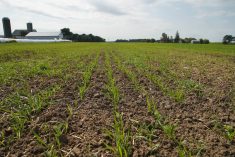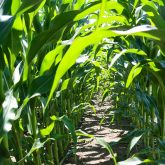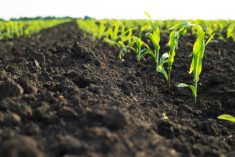There is significant potential to increase yields on Ontario’s hay fields by implementing strategies commonly used growing crops like corn and soybeans.
Why it matters: The Ontario Hay and Forage Co-operator is looking to increase the amount of acres of high quality hay, especially timothy, grown in the province and in order to increase hay acres, the crop has to compete with corn, soybeans and wheat in productivity and profit.
With prospective buyers in the Middle East for Ontario-grown hay, the Ontario Hay and Forage Co-operative hosted a day-long meeting recently in Mount Forest, under the theme “How to Grow Quality Hay for Overseas Export.”
Read Also

Senft to step down as CEO of Seeds Canada
Barry Senft, the founding CEO of the five-year-old Seeds Canada organization is stepping down as of January 2026.
Fritz Trauttmansdorff, chair of the Hay and Forage Co-operative, sees it in simple terms of risk management. With greater certainty of high-paying customers, there’s less risk that a grower will be forced to keep a high-quality hay crop in storage. And this “reduction in risk should allow (more farmers in Ontario) to have (hay) as a standard part of their crop rotation.”
The following are some of the tips for growing and harvesting high-quality, export-ready hay, offered during the recent sessions:
Nitrogen on grass stands: According to Joel Bagg, forage development specialist for Quality Seeds, improvements over the past 40 years in hay production have been huge, but they’ve been improvements in varieties and harvest management, not in agronomy. Research suggests there would be a yield benefit from nitrogen application on any hay with a legume mix of anything less than 50 per cent. With variations in suggested rate based on the percentage of legume in the mix, Bagg’s “practical suggestion” is an application at green-up in the spring, followed by applications following each cut. For dairy farmers aiming to make a cut per month starting in May, or more, he cautioned, the timing window for the post-cut application is going to be tight.
Phosphorus and potassium: “I get asked all the time, what should I fertilize my forage crop with?” Bagg said. “And I say, ‘have you got a soil test?’ If the answer is ‘no,’ well, you’re just winging it.” Consider harvest removal of phosphorus (P) and potassium (K), he says. Lots of dairy farmers he talks to have the understanding that they’re putting back the nutrients through manure application. And that may be true for P. But “the fact is, we don’t see (K replacement) in soil tests, and that’s because, with both alfalfa and corn silage, there’s such a significant removal at harvest. I think there’s a lot of (K deficiency) out there, and I think it’s a major impediment to good yields.”
Starter phosphorous: It’s pretty much universal in corn and soybeans, for good reason. It gets results. “We wouldn’t grow a field of corn or soybeans and say we didn’t put any fertilizer in. We wouldn’t say, ‘oh, I put some on last year so I’ll be okay.’ And yet we do that with forages all the time.” Challenges include application method, given differing seeding methods for hay. But Bagg suggests asking around to figure a way to overcome that challenge.
Sulphur deficiency: “We are seeing some fairly dramatic improvements, particularly on soils and fields that are lower in organic matter,” Bagg said. Applications would be advised “on those older cash crop fields.” There’s much less “free” sulphur from the US than there was before the campaign to curtail acid rain. “We saw a lot of tough-looking stands last June. Wet feet.” The exact problem could have varied; maybe sulphur was leaching away with the moisture or maybe not enough N was readily available. But “there were some dramatic improvements in fields where there was ammonium sulphate application.”
Variety selection: Improvements continue in the development of hay varieties, Bagg says. “They may look the same from the road. But the physiology is different. The plant itself might look quite different.” As a result, there may be significant differences in yield, quality, standability and other factors. You need to choose something that is ideal for your situation — particularly for your harvest schedule and harvest methods, but also for your soil, your quality needs, and for disease resistance. “(Purchasing) cheap seed can be really expensive. That’s not a good place to try and save money.”
Ash content: This parameter “has a big effect in export hay because export hay is getting tested for ash level,” Trauttmansdorff said. A high ash content, agrees OMAFRA Forage and Grazing Specialist Christine O’Reilly, can cause buyers to suspect elevated risk of mycotoxins. The most common way for ash to increase, she adds, is through contact with dirt. This can happen when cutting is done in conditions that are too wet, or if the cutter bar is set too low. It can also happen during tedding/raking/merging if conditions aren’t right. But the most important contributor to keeping ash contents low is storing the hay off the ground. “And that’s easy to do because pallets are usually readily available.”
Raking capacity: “Most of us don’t have enough raking capacity any more in comparison to what we have for cutting and baling,” the Hay and Forage Co-op chair added. Aim for even moisture content/volume on windrows throughout the field. If you’re struggling to keep up with the raking, you’re often going in too early to rake and pushing together rows when they’re still wet, or staying on too late leading to the dried-out leaves getting knocked off.















